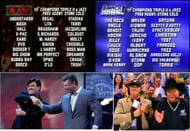
The Ruthless Aggression Era(2002-2008)
The WWE brand split following its acquisition of WCW and ECW.
The hiring of Paul Heyman and Eric Bischoff.
WWE has no plans for these former AEW wrestlers? Here's why!
Declining ratings had forced WCW into bankruptcy at the close of the millennium. With no way around this cul de sac, most WCW wrestlers settled for a WWF contract, ushering in a hotbed of talent which remains unrivalled to this day. The period from 2002 to 2007 marked the growth of incredible performers within the roster, both former WCW and ECW stars as well as company amateurs who would go on to attain main event status. Such an influx called for a split in the product, leading to the brand extension of WWE into Smackdown besides the already existing Raw. This would remain the primary structure till ECW was incorporated in 2005 as a separate brand under WWE’s auspices.
One of the elements which set in chain the events that would lead to the Ruthless Aggression Era was the Invasion storyline. Initially a secondary option, this angle was decided upon after WWF’s failed attempts to get WCW off the ground. No TV Network was willing to touch WCW, whose propensity for losing money had it rolling in the mire of its own disrepute. Even getting WCW a separate twenty-minute slot after one episode of ‘Raw is War’ (July 2, 2001) did not ruffle any feathers with the fans. WWF’s next resort was having WCW wrestlers attack their WWF counterparts throughout the next several months, essentially “invading” WWF. While this storyline created ample space for accommodating the recently doubled ranks of wrestlers, it met its untimely death at the 2001 Survivor Series in a winner-take-all match.
The conclusion of the Invasion angle necessitated the splitting of WWF into two separate brands. Smackdown was reborn as a brand, instead of continuing to be just another WWF program. It was given its own roster, onstage as well as offstage talent and authority figures to make regular appearances on the show. In terms of storyline, Raw came to be owned by Ric Flair who had become Vince’s business partner after buying Shane and Stephanie’s WWF shares which they had sold to a “consortium”, owned by Flair himself. With Vince owning Smackdown and Flair Raw, a draft lottery was initiated.
The pick was held on the March 25, 2002 episode of Raw, where a coin toss was used to determine the first pick. Vince chose The Rock, who went on to memorably turn the crowd at Penn State against Mr. McMahon after the latter had imposed a stop on several of his catchphrases as conditions for staying at Smackdown. Ric Flair’s first choice as the Undertaker came as a shock, mostly because of his storyline feud with the American Bad Ass. Each person got to choose thirty members in total for their respective brands, essentially exhausting the pool.
Such a scheme led to some of the most entertaining storylines and segments of the 2000s. The exclusivity offered by each brand led to the proper utilization of a roster stacked full of performers. From the Undertaker putting over Maven to a debuting John Cena’s “ruthless aggression” before Kurt Angle to cruiserweight wrestlers such as Eddie Guerrero, Chris Benoit and Rey Mysterio gradually moving towards heavyweight championship reigns, this era saw radical ways to involve a wrestler’s talent in ousting the rival brand. Numerous stables, tag teams and the introduction of hardcore matches seized the fancy of viewers across the world. It became possible to involve a number of wrestlers in a match and not have one moment of it drag or bore. Intra-brand feuds, clashes with authority figures, shocking debuts and returns, and brilliantly technical matches became hallmarks of this new period, while the annual draft pick ensured that feuds and lineups never grew stale.
Yet, none of this would have been possible without the mettle that some have exhibited in their creative capacities. During the Invasion days, the WWF commentary table was home to one Paul Heyman . He had recreated the ECW stable and merged it with Shane McMahon’s WCW to form the Alliance. Needless to say, after Survivor Series Heyman was fired from the company (kayfabe). This was in cognizance of his incredible acuity in recognizing talent and building engaging storylines around them, utilizing them to the best of their capacities. Therefore, after the brand split. he became the head writer of Smackdown from July 2002 to February 2003. This period saw the brand surpass Raw in their tussle for ratings and merchandise sales, and set benchmarks which the product follows even to this day. Heyman is often credited with being responsible for the success of the ‘Smackdown! Six’(Eddie Guerrero, Kurt Angle, Chris Benoit, Edge, Rey Mysterio, and Chavo Guerrero), all of whom went on to change the face of the WWE.
Likewise, Eric Bischoff’s managerial acumen had seen WCW soar during its heyday. A man who had revolutionized pro wrestling, his debut on Raw as General Manager started with a continuing heel persona. Though limited to an onscreen role, Bischoff still pitched ideas some of which included the “Raw Roulette” and “Elimination Chamber”. Yet, his involvement in actually advancing the product is slightly ironic, given that he was responsible for a majority of the Monday Night Wars. Much like Joey Styles and Paul Heyman, Bischoff had to bow to the might of the WWE, however disconcerting the state of the product might have seemed to him. Before of course, the man took his leave with a pipe bomb.
How WWE has messed up John Cena's last run - Check here!

